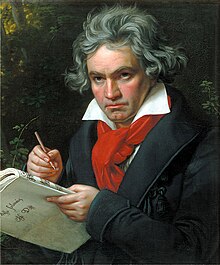Art That Is Created by From the Tortured Soul Within Is Best Described as

Vincent van Gogh, Self-portrait with Bandaged Ear, Easel and Japanese Impress, Jan 1889. Van Gogh, who struggled with poverty and mental illness for well-nigh of his life, is regarded equally a famous example of the tortured creative person.
A tortured artist is a stock grapheme and stereotype who is in abiding torment due to frustrations with art, other people, or the globe in general. The trope is often associated with mental disease.[1]
Groundwork [edit]
The trope of the tortured artist is thought to have been started by Plato.[2]
Creativity and mental illness have been connected over fourth dimension. Some mental disorders, such as bipolar disorder and schizophrenia, have been said to have helped popular artists with their works.[ii] [3] One of the about known "tortured artists" is Vincent van Gogh, who experts consider to accept suffered from psychosis.[4] [one]
Some other figure matching the clarification of the "tortured creative person" is Ludwig van Beethoven, who, after losing his hearing,[5] became increasingly reclusive and apathetic towards club.[half dozen] [7] In the Heiligenstadt Testament, Beethoven confesses his loss of hearing to his brothers Nikolaus and Kaspar and tells them of his inability to converse regularly anymore equally well as his contemplation of suicide.[eight] Towards the end of his life, Beethoven used conversation books[nine] to interact with his friends and acquaintances.

Portrait of Ludwig van Beethoven by Joseph Karl Stieler, painted in 1820, long later on he began to lose his hearing and became reclusive. Beethoven is in a wood writing his Missa Solemnis in D Major.
Criticism and research [edit]
The trope has been criticized for romanticizing mental illness, treating information technology equally a necessary ingredient for creativity.[1] Co-ordinate to a written report conducted at the Academy of Southampton, artwork is perceived to be superior if the observer is told that the artist is mentally ill.[1] Yet, research has found that famous artists' less renowned work was produced when their mental illness was the nearly acute.[10]
Multiple studies accept constitute that rates of mental illness were several times greater than average in artistic professions. Co-ordinate to Victoria Tischler of the University of Westward London, creative fields often take low wages and long working hours, leading to poor mental wellness.[11] [10]
See too [edit]
- Poète maudit
- Self-destructive behaviour
- Starving artist
- Sylvia Plath effect
- 27 Club
References [edit]
- ^ a b c d "van Gogh and Romanticizing the Tortured Artist". Postscript. 2019-03-04. Retrieved 2021-03-30 .
- ^ a b "Scientists: The 'Tortured Artist' Is a Real Thing". world wide web.mentalfloss.com. 2015-06-09. Retrieved 2020-03-18 .
- ^ S4 E22: The Myth of the Tortured Artist | The Art Consignment, 2016-xi-02, retrieved 2020-03-18
- ^ "Van Gogh: Painter 'suffered psychosis' in final 18 months". BBC. 2016-09-16. Retrieved 2021-03-30 .
- ^ "The Deafness of Beethoven: The Medical Conclusion". xiii May 2011.
- ^ "Happy Birthday, Ludwig van Beethoven". 16 Dec 2014.
- ^ "A Glimpse into the Life of Ludwig van Beethoven". sixteen January 2020.
- ^ "SUB Hamburg - HANS". allegro.sub.uni-hamburg.de . Retrieved 2021-ten-24 .
- ^ "The Beethoven Chat Books — what were they?". Bournemouth Symphony Orchestra. 2020-11-05. Retrieved 2021-10-24 .
- ^ a b "The tortured artist is a dangerous myth. It's the way creative workers are treated that causes breakdown". The Independent. 2018-10-x. Retrieved 2021-03-xxx .
- ^ "The myth of the tortured creative person: How New Zealand is safeguarding mental health in the arts". The New Zealand Herald. 2018-11-25. Retrieved 2021-03-xxx .
Further reading [edit]
- Redfield Jamison, Kay (1996). Touched With Fire. New York: Free Press. ISBN068483183X. – looks at the relationship between bipolar disorder and artistic inventiveness. It contains a number of instance histories of dead people who are described as probably having suffered from bipolar disorder.
- Zara, Christopher (2012). Tortured Artists. Avon, Mass: Adams Media. ISBN978-1440530036. – shows the universal nature of the tortured artist stereotype and how it applies to all of the artistic disciplines, including film, theater, literature, music and visual art. The artists profiled in the book have by and large fabricated major contributions to their respective mediums (Charles M. Schulz, Charlie Parker, Lenny Bruce, Michelangelo, Kurt Cobain, Madonna, Andy Warhol, Amy Winehouse, Ernest Hemingway and dozens of others), but the book shows how, in each case, their fine art was inspired by hurting and suffering.
Source: https://en.wikipedia.org/wiki/Tortured_artist